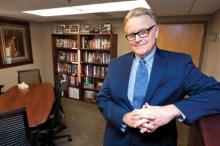As policy makers and payers contemplate the role of primary care under health care reform, some physicians in the Midwest have decided to tackle those questions on their own.
About 34 primary care physicians from Sanford Health, an integrated health care system that spans five Midwestern states, gathered in Bemidji, Minn., for 2 days in October to compare notes on their experiences and come up with a concrete plan for improving the quality and efficiency of the care they provide. The brainstorming session resulted in both a long-term vision and plans for the next 100 days.
Among the items on their immediate to-do list are plans to test group wellness visits, establish service agreements between primary care physicians and subspecialists, and share best practices and innovative ideas by sending physicians to visit other practices around the Sanford system. Sanford officials also plan to educate physicians across their system about the design and basis of quality measures. "Our doctors get a lot of quality data and one of the things that came out of the retreat was that they didn’t always quite know how to react to it or what to do with it," said Dr. Bruce Pitts, president of Sanford Health Clinic North in Fargo, N.D.
The retreat, which included internists, pediatricians, family physicians, ob.gyns., and psychiatrists, was a way for the executives at Sanford to get on-the-ground input on their next 5-year strategic plan for primary care, Dr. Pitts said. It was the first primary care retreat to include physicians from across the system, which has facilities in Minnesota, North Dakota, South Dakota, Nebraska, and Iowa.
But what quickly emerged was a clear picture that primary care physicians across the system are facing similar challenges. Regardless of specialty or practice area, the physicians who participated in the 2-day session agreed that the main problem was how to find the time to do everything they should be doing for their patients. If a primary care doctor provides all the care that is recommended, it would take him or her 18-20 hours each day, Dr. Pitts said. "Therefore, it takes a team and it takes a system," he said.
Dr. Howard Hoody, a family physician in Bemidji, Minn., who attended the retreat, said that primary care physicians feel "pulled in so many different directions at any moment during the day." And for some there is the added sense that the specialty is not appreciated, he said. However, clearly there are many other physicians facing the same challenges, and the retreat generated a lot of ideas on how to move forward, he said.
The electronic health record was one of those common challenges. Sanford has an electronic health record system that is in various stages of implementation. But while it has the potential to improve efficiency, Dr. Pitts said that’s true only if it’s successfully integrated into the practice’s workflow. Dr. Pitts said that for many physicians who were trained in the old way of practicing, it’s a little like spending most of your career as a golfer and then having to learn to play basketball.
"It’s a huge adjustment and it’s not technical; it’s an adaptive adjustment," Dr. Pitts said. "They have to change the way they think and behave, and that’s hard."
The physicians who gathered in Bemidji devoted a lot of time discussing the patient-centered medical home. For instance, the physicians were very interested in the best way to integrate behavioral health services into their practices to provide the full spectrum of care. "When you have a psychologist or a psychiatrist sitting in the office next door, access is easier and people are more willing to go," Dr. Pitts said. It also can be a tool in helping patients with chronic diseases to cope with the anxiety and depression that can accompany those conditions, he said.
The development of the medical home will figure prominently in the system’s long-term plan for primary care, Dr. Pitts said. As part of the 3- to 5-year plan they will also try to tackle some of the thorny issues related to how to recruit and retain primary care physicians in the current health care environment, he said.
As primary care physicians around the country look to take on these same issues, Dr. Pitts advised them to keep their eyes open for opportunities to collaborate, but to choose their partners carefully. "If you’re going to care for a population of patients and get the results that you need to get, it’s going to take relationships and the development of a system," he said.

